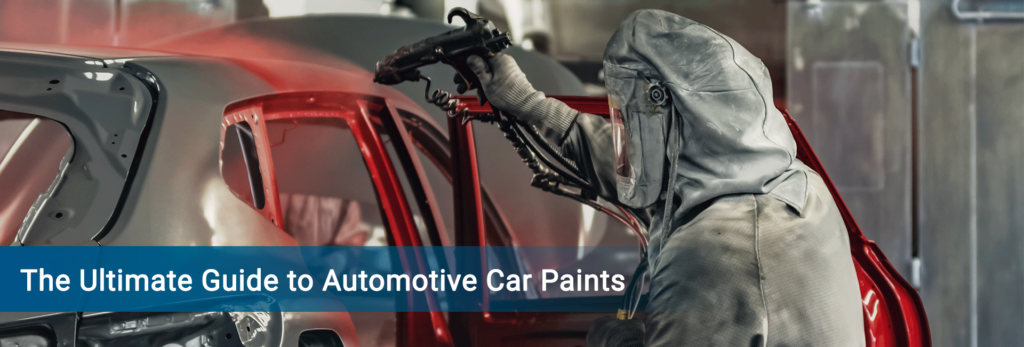Automotive painting is the art and skill of giving your car the necessary upgrade it deserves. It goes beyond just aesthetic transformation, it is functional too. If your car gets banged up with deep scratches or crashes, and the paint comes off to show the metal underneath, you should think about getting it repainted. That exposed metal can start rusting, and rusty parts make your car less sturdy. Plus, if you see white spots on your car, that’s a sign it needs a fresh coat of paint.
There are other signs, too, like bubbling and discoloration. Bubbling happens when the clear coat gets messed up, and the paint underneath starts forming bubbles. That’s a sure sign your car is asking for a new paint job.
On the other hand, discoloration happens when the top coat isn’t done right or if something scratches it off. Without that protective coat, your car’s color starts to fade. To keep it looking good, painting a car is the way to go.
Types of Automotive Paints
Let’s talk about the magic behind automotive car paints – it’s made up of four parts: pigment, thinner, binder, and additives. They all work together to create the perfect paint for your car.
First off, we’ve got pigments – they bring the color and hiding power. There are two types: prime, which adds color and covers well, and extender, which helps the paint stick better. Then, there’s the binder – it holds everything together and forms a dry film. It makes sure the paint performs well, sticks properly, and stays glossy.
Next, we have solvents or liquids – they mix the paint and binder to get the right consistency. Lastly, additives are thickening agents that make the paint denser for a neat application. They prevent messy splatters. Now, let’s talk about the types of automotive paints:
Enamel Paint
Enamel paint is tough and stands up to scratches and chips well. It’s great for cars in rough conditions, as it can handle extreme fluctuations in temperatures and harsh weather. But, it takes its time to dry, gives off strong fumes, and needs good ventilation when you’re painting.
Acrylic Paint
Acrylic paint is water-based, so it’s easier to work with and dries faster than enamel. It’s also eco-friendly, with fewer fumes. But it’s not as durable as enamel, so it might not hold up as well in harsh weather. Plus, it’s more prone to fading and chipping.
Urethane Paint
Urethane paint is top-notch when it comes to durability – it’s hard to scratch, chip, or fade. It dries fast and leaves a shiny finish. However, it’s pricier and trickier to apply compared to other paints.
Waterborne Paint
Waterborne paint for automobiles is solvent-free and uses only water as its solvent. You can use it on various surfaces, whether it’s over a primer coat, plain metal, or a fresh coating. These are more eco-friendly and don’t let out any harmful organic compounds into the air like solvent-based paints do.
Techniques for Applying Auto Car Paints
Painting a car involves several important stages, and it’s not as simple as using a brush on a canvas. Here’s a breakdown of the process:
Preparation Stage: Sandblasting
Before anything else, the car undergoes sandblasting. This process removes impurities, old paint, rust, and contaminants from the surface. It’s important to create a clean surface for the paint to stick properly.
Stage 1: Primer
After sandblasting, the next step is applying primer. Primer is a special paint containing resin, solvents, and additives. It prepares the car surface for painting by leveling it and addressing any defects from manufacturing. The primer also protects the metal body from rust, high temperatures, stones, and UV rays.
Stage 2: Base Coat
The base coat or color coat is the second step. This is where the car gets its color and visual appeal. There are four types of base coats: solid, metallic, pearlescent, and matte, each providing a different finish.
Stage 3: Clear Coat
The final stage of automotive body painting is applying the clear coat. This transparent layer is applied over the base coat. It needs to be durable, protecting the surface from external abrasion and harmful UV rays. The clear coat is important for maintaining the paint’s longevity and appearance.
Throughout these stages, it’s essential to work in a closed and clean environment, use the right tools for sanding and painting, and take measures to shield areas that shouldn’t be painted. Treating rust and ensuring a dust-free surface are also important steps in achieving a smooth and lasting car paint finish.
Paint Circulation System for Automotive Painting
Paint circulation systems have revolutionized the way businesses apply coatings and are essential to modern manufacturing. To achieve the desired finishes, consistent viscosity and color dispersion must be maintained by effective paint circulation. These systems maximize productivity, cut expenses, and improve overall quality by guaranteeing uniform paint flow and distribution.
Proper circulation is necessary to prevent Automotive Paint from settling, which can result in application errors and worse quality. Paint circulation system advantages include the following:
- Boost efficiency in the paint mixing room
- Lower operating and maintenance costs
- Reduce Downtime
- Enhances working conditions
- Promotes sustainability
- Improved efficiency
- Cutting down on paint waste
- Accurate and consistent coating
- Protection against corrosion
- Consistent quality
Conclusion
Selecting the right type of paint for Automotive is vital for both protection and achieving a great finish. Experienced car painters at auto body repair shops can guide you through the process, ensuring you choose the right paint for your vehicle and providing top-notch painting services. Also, understanding the advantages and disadvantages of each paint type will help you make a well-informed choice, ensuring your car looks fantastic and stays protected!
FAQs
The main layers are E-coat, Primer, Basecoat, & Clearcoat. E-coat is the first layer applied to the bare metal surface of the vehicle. The primer layer is applied on top of the e-coat to enhance adhesion. The basecoat is the layer where the color of the vehicle is applied. The clearcoat is the final layer applied to the vehicle.
Urethane paint stands out as the most enduring option, resistant to quick fading. It surpasses many water-based acrylic paints in durability and affordability, drying rapidly upon application.
While repainting your vehicle yourself is possible, it demands patience, skill, and acquiring specific paints and tools for the task. However, keep in mind that the outcome of painting a car on your own may not yield the high-quality changeover you expect for your vehicle.



